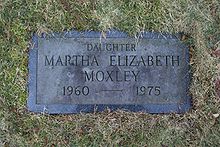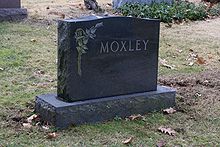- Martha Moxley
-
Martha Elizabeth Moxley (August 16, 1960–October 30 or 31, 1975) was a 15-year-old murder victim in a case that attracted worldwide publicity owing to a "Kennedy connection".[1]
Moxley was born in San Francisco, California, to Dorthy and David Moxley and lived in Piedmont, California. Martha and her family settled in Belle Haven, an affluent section of Greenwich, Connecticut. Her circle of friends included neighbors Thomas and Michael Skakel, nephews of Ethel Kennedy.
Contents
Murder
On the evening of October 30, 1975, Moxley left with friends to attend a Halloween party at the Skakel home, one block away. According to friends, Moxley began flirting with and eventually kissed Thomas Skakel. Moxley was last seen "falling together behind the fence" with Thomas Skakel near the pool in the Skakel backyard at around 9:30 p.m.
The next day, Moxley's body was found underneath a tree in her family's backyard. Her trousers and underwear were pulled down, but she had not been sexually assaulted. Pieces of a broken six-iron golf club were found near the body. An autopsy indicated she had been both bludgeoned and stabbed with the club, which was traced back to the Skakel home.
Initial investigation
Thomas Skakel was the last person known to have been seen with Moxley the night of the murder and had a weak alibi. Thomas Skakel became the prime suspect, but his father forbade access to his school and mental health records. Kenneth Littleton, who had started working as a live-in tutor for the Skakel family only hours before the murder, also became a prime suspect. No one was charged, however, and the case languished for decades. In the meantime, several books were published about the crime, including Timothy Dumas' A Wealth of Evil and the novel A Season in Purgatory by Dominick Dunne, a fictional account of the case.
Over the years, both Thomas and Michael Skakel significantly changed their alibis for the night of Moxley's murder. Michael Skakel claimed that he had been window-peeping and masturbating in a tree beside the Moxley property from 11:30 p.m. to 12:30 a.m. Two former students of a drug rehab center that Michael Skakel attended in 1978 testified that they heard Skakel confess to killing Moxley with a golf club. According to then Elan resident Gregory Coleman, Skakel then bragged, "I'm going to get away with murder. I'm a Kennedy."[2]
Investigation re-opened
When William Kennedy Smith was tried for rape in 1991, a rumor surfaced that he had been present at the Skakel house on the night of the Moxley murder, with the clear insinuation that he might have been involved. Although this rumor proved to be unfounded, it resulted in renewed investigation of the then cold case.[3] In 1993 author Dominick Dunne, father of murdered actress Dominique Dunne, published A Season in Purgatory, a fictional story closely resembling the Moxley case. Mark Fuhrman's 1998 book Murder in Greenwich named Michael Skakel as the murderer and pointed out numerous mistakes the police had made in investigating the crime. During the years before the Dunne and Fuhrman books, work had been done by Greenwich Police detectives Steve Carroll and Frank Garr and police reporter Leonard Levitt that named Michael Skakel as the killer.
Trial
In June 1998, a rarely invoked one-man grand jury was convened, and after 18 months (in June 2000) Michael Skakel was indicted for the murder of Martha Moxley. In a highly publicized trial, Skakel was convicted for the murder of Martha Moxley on June 7, 2002, and received a sentence of 20 years to life in prison. Skakel's alibi was that at the time of the murder he was at his cousin's house. During the trial the jury heard part of a taped book proposal, which included Skakel speaking about masturbating in a tree on the night of the murder—the same tree under which Martha Moxley's body was found the next morning. Skakel never admitted to killing Moxley. Prosecutors took words from this proposal and overlaid them on graphic images of Moxley's dead body in a computerized, multi-media presentation shown to jurors during closing arguments. In the audiotape, Skakel said that when he was awoken the next morning, he was afraid he might have been seen the previous night "jerking off", and he felt panicked. The prosecutor deleted the portion of the audiotape where Skakel said "jerking off", giving the impression that he was confessing to the murder. When journalist Leslie Stahl confronted the prosecutor about his presentation, the prosecutor said it had been completely appropriate.[4]
The prosecutors' use of the multimedia presentation during closing arguments was included in Skakel's initial appeal and the judge ruled, "The state engaged in appropriate and effective advocacy by using trial exhibits to highlight certain evidence and inferences.... Just as the state should not be deprived of its most valuable evidence unless there is a compelling reason to do so, the state should not be prohibited from making its best arguments. The state's use of audio and photographic exhibits during argument was a matter of effective advocacy. The state did not, as defendant claims, distort the evidence in any respect. By placing certain exhibits next to defendant's words, or by displaying two related exhibits simultaneously, the state was making explicit the inferences it was asking the jury to draw. This is the job of an advocate...."
Post-trial
In January 2003, attorney Robert F. Kennedy, Jr., Skakel's cousin, wrote a controversial article in The Atlantic Monthly entitled "A Miscarriage of Justice," insisting that Skakel's indictment "was triggered by an inflamed media, and that an innocent man is now in prison". Kennedy's article[5] presents the argument that there is more evidence suggesting that Kenneth Littleton, the Skakel family's live-in tutor, killed Moxley. He also calls Dominick Dunne the "driving force" behind Skakel's prosecution.[5]
Appeal and post-conviction proceedings
Skakel continued to fight his conviction. In November 2003, Skakel appealed to the Connecticut Supreme Court, arguing that the trial court erred because the case should have been heard in Juvenile Court rather than Superior Court, that the statute of limitations had expired on the charges against him, and that there was prosecutorial misconduct. On January 12, 2006, however, the Connecticut Supreme Court rejected Skakel's claims and affirmed his conviction. Subsequently, Skakel retained attorney and former United States Solicitor General Theodore Olson, who on July 12, 2006, filed a petition for a writ of certiorari on behalf of Skakel before the Supreme Court of the United States. On November 13, 2006, the Supreme Court declined to hear the case.[6]
Since then, Skakel has begun his first round of postconviction proceedings, beginning with a petition for writ of habeas corpus and motion for new trial in the Connecticut trial court which originally heard his case. Skakel's cousin Robert F. Kennedy, Jr. has brought forth Gitano "Tony" Bryant, cousin of Los Angeles Lakers player Kobe Bryant and a former classmate of Skakel at the private Brunswick School in Greenwich, Connecticut. In a videotaped interview with Skakel private investigator Vito Colucci in August 2003, Bryant said one of his companions the night of Moxley's murder wanted to "go caveman" on her, meaning violently have his way with her. Bryant says he never came forward before because his mother warned him, and he believed her, that as a black man he would be tagged for the unsolved murder. A two-week hearing in April 2007 allowed the presentation of this hearsay evidence, among other matters.[7] In September 2007, Skakel's attorneys filed a petition, based in part on Bryant's claims, asking for a new trial; prosecutors formally responded that Bryant may have made up the story to sell a play about the case.[8]
The new Skakel defense team also hired a full-time investigative team to review existing and new information—particularly a book written about Élan School—in preparation for the hearing. They argued that no Élan School residents with Skakel, other than Gregory Coleman, ever spoke about Skakel's confession to anyone, including the author of the book.
On October 25, 2007, a Superior Court judge denied the request for a new trial, saying Bryant's testimony was not credible and there was no evidence of prosecutorial misconduct in the original trial. Skakel's lawyer indicated she would appeal this decision.[9]
Notes
- ^ Martha Moxley at Crime Library
- ^ http://www.trutv.com/library/crime/notorious_murders/famous/moxley/trial_9.html
- ^ http://www.courant.com/news/local/fc/hc-07161555.apds.m0636.bc-ct--skakjun07,0,6734066.story
- ^ The Ghosts of Greenwich, 48 Hours, August 30, 2008, 34 minutes into story
- ^ a b Kennedy, Robert F. Jr (January/February 2003). "A Miscarriage of Justice". The Atlantic Monthly. http://www.theatlantic.com/doc/200301/kennedy-skakel.
- ^ "Skakel Murder Conviction Left Intact by U.S. Supreme Court," Bloomberg, November 13, 2006
- ^ "Skakel Heads Back To Court," Hartford Courant, April 17, 2007
- ^ Christoffersen, John (September 14, 2007). "Attorneys spar over Skakel's trial bid". USA Today. http://www.usatoday.com/news/nation/2007-09-14-3426051165_x.htm.
- ^ Christoffersen, John (October 25, 2007). "Attorney: Judge denies Skakel's bid for a new trial". Associated Press. http://www.boston.com/news/local/connecticut/articles/2007/10/25/attorney_judge_denies_skakels_bid_for_a_new_trial/.
References
- Fuhrman, Mark (1998). Murder in Greenwich: Who Killed Martha Moxley?. ISBN 0-06-019141-4.
- Levitt, L. (2004). Conviction: Solving the Moxley Murder. ISBN 0-06-054430-9.
External links
- Crime Library: The Martha Moxley Murder
- Martha Moxley at Find a Grave
- MarthaMoxley.com website of a friend and former classmate
- Exclusive: Ghosts Of Greenwich from CBS News September 10, 2003
- Complete Skakel trial coverage from Court TV
- R.Kennedy involvement
- "Miscarriage of Justice" by Robert F. Kennedy Jr.
- Sutton Report
Categories:- 1960 births
- 1975 deaths
- People from Greenwich, Connecticut
- People from San Francisco, California
- Murdered American children
- People murdered in Connecticut
- Kennedy family
Wikimedia Foundation. 2010.


